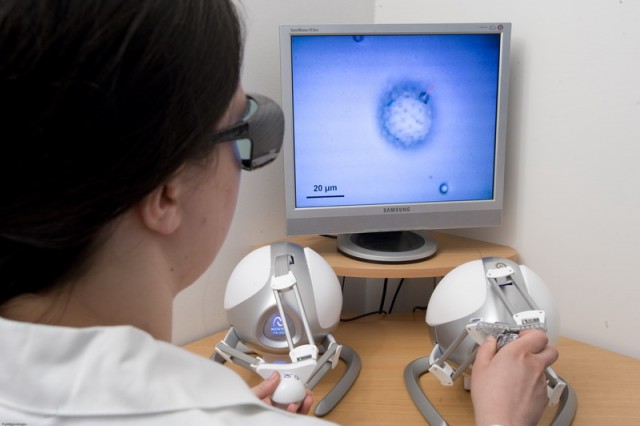A light touch
New twist on microscopic technique lets users feel the forces pressing in on particles
Sarah Lewin • October 17, 2013

Moving particles with touch-feedback controllers makes microscopic tasks easier and more intuitive [Image source: Cecile Pacoret]
Microscopic particles have a lot to contend with. They’re bombarded from all sides by the molecules of fluid they float in, pulled together by static electricity and even held at the mercy of light itself. Scientists have been moving particles under the microscope using nothing but a beam of light since the 1980s. In doing so, they’ve explored the components of living cells, revealed the physical properties of molecules, and measured how far DNA can be stretched. Now, researchers are taking that sense of discovery to the next level: They’re letting users actually feel the forces pressing in on the particles by using optical tweezers that give physical touch feedback.
Optical tweezers work by trapping a molecule, cell or small plastic bead at the end of an intense beam of light, where electromagnetic effects hold it at the brightest point. By moving the light, the tweezers are then able to directly move the object — as in this quirky video. In a September paper in Review of Scientific Instruments, nanorobotics researcher Cecile Pacoret and her colleagues at Université Pierre et Marie Curie in Paris explored the benefits and challenges of helping the operator feel the forces at the end of that beam. They hope to make a seamless connection between the tweezers and a controller, so the user can focus totally on the task at hand.
“The more we match the perception of what we’re doing to the movement under the microscope, the more we’re able to get used to a task and do it faster,” says Pacoret. “Our idea is to give some sensation back to the operator.”
To give touch feedback, a camera first observes the forces pressing against a microscopic bead held by the optical tweezers. Then, motors pressing on a joystick-like controller recreate those forces, amplified, to the user. Pacoret’s first tests with the tweezers, in 2009, involved tracing a cube’s contours and maneuvering a bead into a crack in a piece of chrome. Subjects found these tasks much easier using their sense of touch rather than relying on just visuals.
“If tasks in the microworld are sufficiently complex, or if you don’t know exactly what it is you’re looking for, you should provide the user with as much feedback as possible,” says Allison Okamura, a researcher at Stanford University in California. “But if you provide all the information through the visual channel, they may not be able to process it all.” Okamura works on a similar touch feedback system for robot-aided surgery which, like micro-manipulation, needs to convey fast, intuitive information to an operator.
Pacoret points to DNA manipulation as one area where such information would be helpful. For instance, if researchers stretch out the DNA to examine its properties without touch feedback, they are much more likely to tear the long, fragile molecule than if they can feel the tension growing as they pull.
David Grier, a physicist at New York University who works with optical tweezers regularly, says that although he can’t think of how he’d personally use touch feedback, any technology that boosts optical tweezers’ ability for exploration will lead to new discoveries. “Optical tweezers open up the door to doing things that have been impossible,” he says. “They’re naturally a mechanism for trying things out, and having a new way to experience the information can only be valuable.”
With the device’s help, Pacoret has already felt the force of fluid molecules throwing themselves against the plastic bead held by optical tweezers firsthand. She describes feeling the erratic attack, with force scaled up a trillion times by the controller. It’s a barrage on the molecular level. But for Pacoret, “It’s a very relaxing sensation.”
[Check out these other innovative uses of optical tweezers: Studying how immune system destroys pathogens, building microscopic structures (PDF), stretching DNA. Also, an iPad app.]